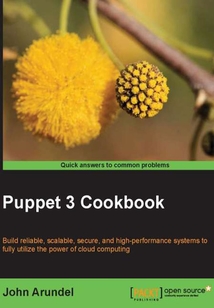舉報 

會員
Puppet 3 Cookbook
最新章節:
Index
Puppet3CookbookiswritteninaCookbookstyle,showingyouhowtosetupandexpandyourPuppetinfrastructure.ItnotonlygivesyoueverythingyouneedtobecomeaPuppetexpert,butincludespowerfulcodesamplesandtechniquesdevelopedovermanyyearsofproductionexperience.Withit,you’llsavetimeandeffortbyautomatingtediousmanualprocesses,impressyourbossbydeliveringbetterbusinessvaluefromIT,andfuture-proofyourcareerbygettingtogripswiththenewtechnologiesrevolutionizingtheindustry."Puppet3Cookbook"isforanyonewhobuildsandadministersservers,especiallyinaweboperationscontext.ItrequiressomeexperienceofLinuxsystemsadministration,includingfamiliaritywiththecommandline,filesystem,andtextediting.Noprogrammingexperienceisrequired.
目錄(118章)
倒序
- coverpage
- Puppet 3 Cookbook
- Credits
- About the Author
- About the Reviewers
- www.PacktPub.com
- Support files eBooks discount offers and more
- Preface
- What this book covers
- What you need for this book
- Who this book is for
- Conventions
- Reader feedback
- Customer support
- Chapter 1. Puppet Infrastructure
- Introduction
- Installing Puppet
- Creating a manifest
- Managing your manifests with Git
- Creating a decentralized Puppet architecture
- Writing a papply script
- Running Puppet from cron
- Deploying changes with Rake
- Bootstrapping Puppet with Rake
- Automatic syntax checking with Git hooks
- Chapter 2. Puppet Language and Style
- Introduction
- Using community Puppet style
- Checking your manifests with puppet-lint
- Using modules
- Using standard naming conventions
- Using inline templates
- Iterating over multiple items
- Writing powerful conditional statements
- Using regular expressions in if statements
- Using selectors and case statements
- Using the in operator
- Using regular expression substitutions
- Chapter 3. Writing Better Manifests
- Introduction
- Using arrays of resources
- Using definitions
- Using dependencies
- Using tags
- Using run stages
- Using node inheritance
- Passing parameters to classes
- Using class inheritance and overriding
- Writing reusable cross-platform manifests
- Getting information about the environment
- Importing dynamic information
- Passing arguments to shell commands
- Chapter 4. Working with Files and Packages
- Introduction
- Making quick edits to config files
- Using Augeas to automatically edit config files
- Building config files using snippets
- Using ERB templates
- Using array iteration in templates
- Using GnuPG to encrypt secrets
- Installing packages from a third-party repository
- Building packages automatically from source
- Comparing package versions
- Chapter 5. Users and Virtual Resources
- Introduction
- Using virtual resources
- Managing users with virtual resources
- Managing users' SSH access
- Managing users' customization files
- Efficiently distributing cron jobs
- Using schedules to limit when resources can be applied
- Using host resources
- Using multiple file sources
- Distributing directory trees
- Cleaning up old files
- Auditing resources
- Temporarily disabling resources
- Chapter 6. Applications
- Introduction
- Managing Apache servers
- Creating Apache virtual hosts
- Creating Nginx virtual hosts
- Managing MySQL
- Managing Ruby
- Chapter 7. Servers and Cloud Infrastructure
- Introduction
- Building high-availability services using Heartbeat
- Managing NFS servers and file shares
- Using HAProxy to load-balance multiple web servers
- Managing firewalls with iptables
- Managing EC2 instances
- Managing virtual machines with Vagrant
- Chapter 8. External Tools and the Puppet Ecosystem
- Introduction
- Creating custom facts
- Adding external facts
- Setting facts as environment variables
- Importing configuration data with Hiera
- Storing secret data with hiera-gpg
- Generating manifests with puppet resource
- Generating manifests with other tools
- Testing your manifests with rspec-puppet
- Using public modules
- Using an external node classifier
- Creating your own resource types
- Creating your own providers
- Creating your own functions
- Chapter 9. Monitoring Reporting and Troubleshooting
- Introduction
- Doing a dry run
- Logging command output
- Logging debug messages
- Generating reports
- Producing automatic HTML documentation
- Drawing dependency graphs
- Understanding Puppet errors
- Inspecting configuration settings
- Index 更新時間:2021-04-09 23:52:48
推薦閱讀
- 中文版After Effects CC 2020完全自學一本通
- Word論文排版之道
- VSTO 3.0 for Office 2007 Programming
- CorelDRAW服裝設計實用教程(第四版)
- SOLIDWORKS 2021中文版基礎入門一本通
- ASP.NET MVC 2 Cookbook
- Drools JBoss Rules 5.0 Developer's Guide
- Getting Started With Oracle SOA Suite 11g R1 – A Hands/On Tutorial
- VR策劃與編導
- ASP.NET Core 3從入門到實戰
- 中文版Illustrator 2020基礎教程
- AutoCAD 2022中文版從入門到精通(標準版)
- Adobe創意大學InDesign產品專家認證標準教材(CS6修訂版)
- 中文版CINEMA 4D R20 實用教程
- 科技繪圖/科研論文圖/論文配圖設計與創作自學手冊:科研動畫篇
- Photoshop海報設計技巧與實戰
- CAD/CAE技術應用
- LaTeX論文寫作教程
- HBase企業應用開發實戰
- Service Oriented Architecture with Java
- Microsoft Dynamics Sure Step 2010
- Photoshop后期強:攝影后期影調與調色實戰寶典
- SketchUp 2016草圖大師從入門到精通(第2版)
- AutoCAD 2018中文版室內裝潢設計(第6版)
- After Effects CS6基礎培訓教程(第2版)
- CMS Made Simple 1.9 Beginner?s Guide: LITE Edition
- Oracle Weblogic Server 11gR1 PS2: Administration Essentials
- UG NX 5中文版產品設計技法與典型實例
- Excel 2016數據處理與分析(微課版)
- UG NX 12.0快速入門及應用技巧

